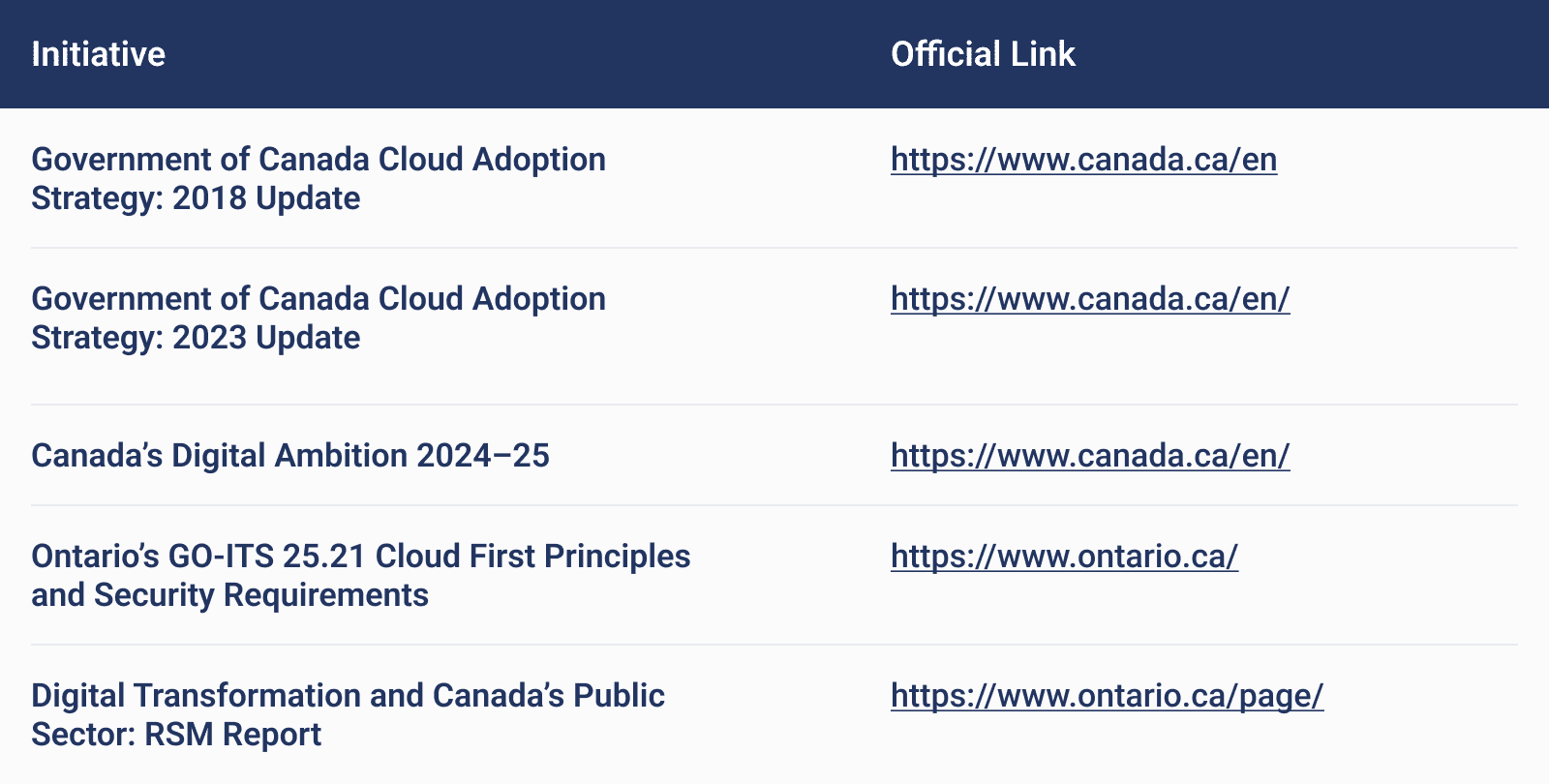How Integrio Can Help Canadian Government Authorities with IT Modernization

In Canada, many government departments are still managing aging systems that slow down collaboration, limit data sharing, and pose growing security risks. To address these challenges, Canada’s federal and provincial “cloud first” and digital transformation initiatives are pushing authorities to modernize how they deliver public services.
What does such an IT modernization strategy bring to the table? It unlocks smarter data use, automation, and more responsive digital experiences for citizens. As an experienced Canadian software partner, Integrio Systems will discuss how authorities can modernize their infrastructure, data, and apps — and why they should do that immediately.
Why Government Authorities Across Canada Are Modernizing IT Systems
Canada’s modernization plans are largely driven by the demands of Canadians themselves. But that’s not the only reason. Here are more factors making the impact:
- Outdated systems are expensive, hard to secure, and slow. Maintaining legacy, on-premises systems is a financial drain — typically, a significant portion of the IT budget is spent simply keeping the lights on. Besides, such systems are rigid, which makes it almost impossible to patch vulnerabilities.
- Citizens expect digital, mobile, and transparent public services. Digital services for Canadians must be intuitive and barrier-free, which isn’t currently the case. Ensuring mobile access and a “tell us once” approach to data might be necessary for updating government software.
- Cybersecurity threats are rising. Government data, including sensitive citizen and national security information, is the number one target for cyberattacks. As we just mentioned, outdated systems can’t be protected to the extent that modern ones are designed to be.
- Remote and hybrid work require modern infrastructure. With the shift to remote/hybrid work models, authorities need a secure and efficient way to keep their operations running from any place. Legacy VPNs and on-prem software clearly don’t help with that.
- Climate and sustainability goals. Governments across Canada are highly focused on the longevity of their investments in tech. They aim not just to modernize, but to build operations that’ll stay reliable and resilient in the years to come.
Key Government References for Canada’s “Cloud First” and Digital Transformation Initiatives

What’s Shaping Modernization Efforts Across Canadian Authorities
Now that you know the “why” behind legacy systems modernization in Canada, let’s explore the “how.” Here’s what defines the major modernization efforts being implemented:
Federal Frameworks
The most important guidance for updating IT infrastructure in Canada is the foundational documents published by the Treasury Board of Canada Secretariat. These are the directives that comprise:
- Cloud Adoption Strategy. Created in response to the “cloud first” requirement, this document explicitly directs federal organizations to consider cloud solutions as the default choice for IT service delivery.
- Canada’s Digital Ambition. Lays out a clear, integrated vision for service delivery, security (including cybersecurity), privacy, data governance, AI integration, and digital talent.
Shift in Approach
For years, many government IT teams were trapped in a cycle of reactive maintenance, repairing outdated systems after sudden breakdowns. That mindset is finally changing. Canadian authorities are finally adopting a philosophy of continuous modernization, prioritizing:
- Early upgrades. Investing in regular, smaller-scale improvements instead of massive, risky “big bang” projects.
- Automation initiatives. Increasingly using AI for automated decision-making, as suggested by the Directive on Automated Decision-Making.
Key Modernization Pillars
A renewed Canadian government system depends on the following three pillars:
- Data interoperability. Modernization efforts will focus on establishing common data standards and guidelines for secure, legal data sharing across jurisdictions and departments. A “tell us once” environment will contribute to that significantly.
- AI readiness. The Guide on the Use of Generative Artificial Intelligence explore the use of AI for everything, whether fraud detection or improving healthcare wait times. Following this document will ensure AI is used ethically and responsibly.
- PIPEDA-aligned privacy compliance. The privacy laws of Canada, such as the federal Personal Information Protection and Electronic Documents Act (PIPEDA) and its provincial counterparts, require the utmost privacy protection. The modernized systems will follow these non-negotiably.
What IT Modernization of Government Systems Actually Involves
Modernization is a series of incremental, interconnected efforts aimed at improving digital services for Canadians.
At first glance, modernization may seem like buying brand-new computers or installing new apps. However, for most authorities, the process is not even close to that. It typically starts with rebuilding the foundation: migrating to the cloud, connecting fragmented data, and introducing governance standards that make that data accessible and useful across departments.
Here are the components that make modernization possible:
- Hardware layer. Some on-premises hardware might be replaced or upgraded. Yet, the prevailing strategy is migration to the cloud infrastructure, either public, private, or hybrid.
- Software layer. At the application level, modernization efforts aim at transitioning from monolithic architectures. The new systems are modular, API-based.
- Data and governance layer. Focuses on connecting previously siloed datasets and requires the implementation of the new governance frameworks for data privacy and security.
Challenges Government IT Teams Face
Even when modernization efforts are in place, government IT teams often find themselves balancing progress with practicality. Here are the primary challenges they face:
- Long procurement cycles and fixed budgets. Unlike the private sector, which can quickly pivot and fund new initiatives, public sector IT projects are often constrained by lengthy procurement cycles and tightly defined budgets.
- Data sovereignty and compliance complexity. Certain types of data must reside and be processed within Canada, as well as comply with federal and provincial privacy regulations, which makes modernization, especially cloud migration, more complicated.
- Vendor lock-in with outdated solutions. Lots of legacy systems were built decades ago by vendors who imposed long-term contractual obligations. Updating or switching from such solutions today often involves resource-intensive development or high exit fees.
- Fragmented data and a lack of integration. While modernization aims to connect siloed data, doing so isn’t straightforward. IT teams have to dig into separate departments of federal and provincial agencies to standardize, clean, and integrate these disparate datasets.
- Shortage of modernization expertise. Even with a modernization plan, authorities may struggle to find the right people to implement it. IT teams must have diverse expertise, including cloud engineering, data governance, and cybersecurity, which isn’t easy to recruit and retain.
The Benefits for Citizens
By now, you see that government IT teams have to deal with plenty of modernization challenges on a daily basis. Integrio Systems tackles that with modern, citizen-centric solutions. In particular, we offer:
- Personal or online consultation. Government representatives can define priorities and outline next steps by meeting with our executives in person (at our Vancouver office or other Canadian locations) or simply booking an online consultation via Calendly.
- Modernization planning. Once the scope and requirements are outlined, our Vancouver software development and modernization company prepares a tailored modernization plan, which includes risk assessment, project milestones, and compliance requirements.
- System & architecture audits. Before changing anything, our experts conduct an audit of your existing systems and IT architecture to identify gaps.
- Cloud & hybrid migration. We ensure secure, compliant migration to public, private, or hybrid cloud infrastructure, according to your requirements.
- Data platform development. We can help Canadian authorities clean and centralize their data in a modern data management solution.
- Application modernization. In case we identify outdated components in your apps, we can substitute them with modern solutions. Besides that, we move applications from monolithic to modular, API-first architectures.
- AI & analytics integration. If necessary, our specialists help integrate AI and advanced analytics tools, from natural language solutions to predictive dashboards.
- Ongoing support. After the modernization plan has been executed, Integrio Systems continues to support your digital solutions. We handle regular audits, ongoing maintenance, security updates, performance monitoring and optimization, and beyond.
Conclusion
Some of Canada’s government departments clearly need modernization, and the country is actively working on the matter. While particular challenges still exist, the complete transition from legacy systems to cloud-first, federal framework-led, secure platforms is underway.
In case you are looking for a partner to devise a modernization plan for your department, contact Integrio Systems. With proven expertise in modernization planning, cloud migration, and app enhancement, we can assist in building the next chapter of Canada’s digital government.
FAQ
Integrio Systems strictly follows Canadian federal and provincial data protection frameworks, such as PIPEDA, Policy on Government Security, Policy on Privacy Protection, Government of Canada’s Enterprise Cyber Security Strategy, and “cloud first” guidelines.
Yes. Our modernization process and data migration strategy are planned in small, incremental stages. This allows us to transform outdated operations into cutting-edge ones with minimal downtime.
Your primary step is to find a reputable modernization vendor with a proven background in the public sector. After you’ve located one, schedule a consultation with modernization experts. During the conversation, discuss your most challenging workflows and systems and outline your priorities and modernization goals.
Yes. As a local company in Canada, we collaborate with federal departments, provincial agencies, and municipal organizations.
Canadian officials may arrange a meeting with one of our executives in Vancouver or other Canadian destinations, visit our office in Vancouver, or arrange an online consultation through Calendly. They may also reach out to us via the contact form on our website or call us at +1 (888) 338-7638.
Contact us

